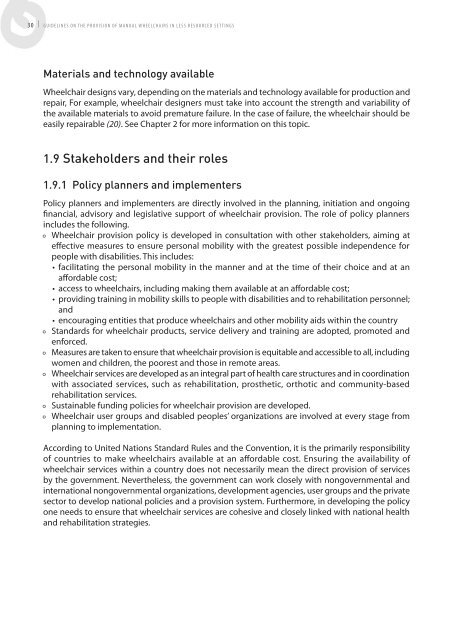Manual Wheelchairs - World Health Organization
Manual Wheelchairs - World Health Organization
Manual Wheelchairs - World Health Organization
Create successful ePaper yourself
Turn your PDF publications into a flip-book with our unique Google optimized e-Paper software.
30 I guIdelInes on the provIsIon of manual wheelchaIrs In less resourced settIngs<br />
Materials and technology available<br />
Wheelchair designs vary, depending on the materials and technology available for production and<br />
repair, For example, wheelchair designers must take into account the strength and variability of<br />
the available materials to avoid premature failure. In the case of failure, the wheelchair should be<br />
easily repairable (20). See Chapter 2 for more information on this topic.<br />
1.9 Stakeholders and their roles<br />
1.9.1 Policy planners and implementers<br />
Policy planners and implementers are directly involved in the planning, initiation and ongoing<br />
financial, advisory and legislative support of wheelchair provision. The role of policy planners<br />
includes the following.<br />
• Wheelchair provision policy is developed in consultation with other stakeholders, aiming at<br />
effective measures to ensure personal mobility with the greatest possible independence for<br />
people with disabilities. This includes:<br />
• facilitating the personal mobility in the manner and at the time of their choice and at an<br />
affordable cost;<br />
• access to wheelchairs, including making them available at an affordable cost;<br />
• providing training in mobility skills to people with disabilities and to rehabilitation personnel;<br />
and<br />
• encouraging entities that produce wheelchairs and other mobility aids within the country<br />
• Standards for wheelchair products, service delivery and training are adopted, promoted and<br />
enforced.<br />
• Measures are taken to ensure that wheelchair provision is equitable and accessible to all, including<br />
women and children, the poorest and those in remote areas.<br />
• Wheelchair services are developed as an integral part of health care structures and in coordination<br />
with associated services, such as rehabilitation, prosthetic, orthotic and community-based<br />
rehabilitation services.<br />
• Sustainable funding policies for wheelchair provision are developed.<br />
• Wheelchair user groups and disabled peoples’ organizations are involved at every stage from<br />
planning to implementation.<br />
According to United Nations Standard Rules and the Convention, it is the primarily responsibility<br />
of countries to make wheelchairs available at an affordable cost. Ensuring the availability of<br />
wheelchair services within a country does not necessarily mean the direct provision of services<br />
by the government. Nevertheless, the government can work closely with nongovernmental and<br />
international nongovernmental organizations, development agencies, user groups and the private<br />
sector to develop national policies and a provision system. Furthermore, in developing the policy<br />
one needs to ensure that wheelchair services are cohesive and closely linked with national health<br />
and rehabilitation strategies.

















